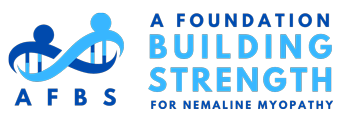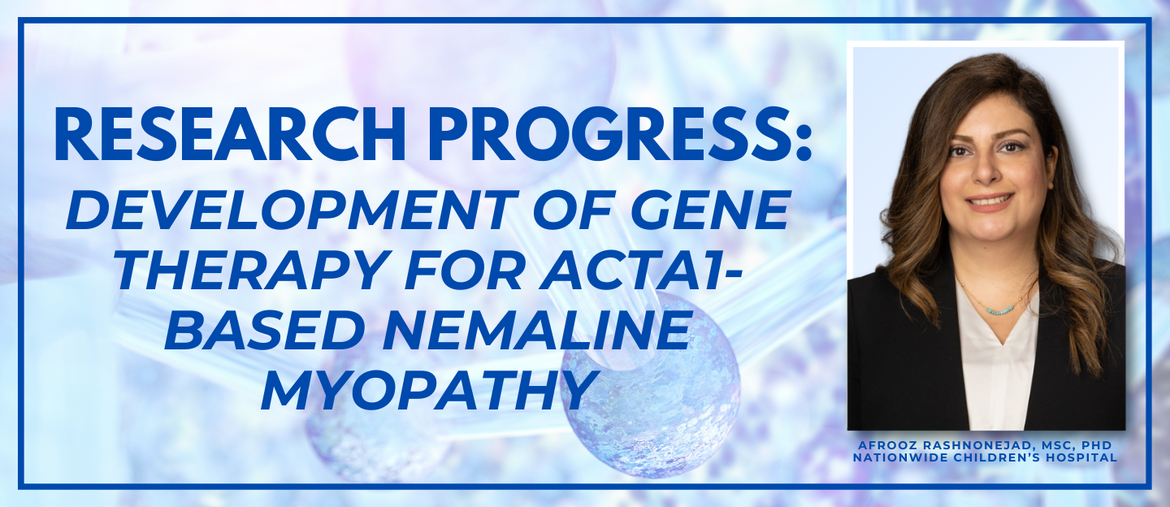We’re excited to share some encouraging news on the front lines of Nemaline Myopathy research. Dr. Afrooz Rashnonejad and her team, funded by the support of AFBS, have been making strides in developing a potential gene therapy for NEM3, a form of Nemaline Myopathy caused by mutations in the ACTA1 gene.
Nemaline Myopathy Gene Therapy: The Science in Simple Terms
In essence, Dr. Rashnonejad’s lab is working to silence the faulty ACTA1 gene and replace it with a healthy one. They’ve developed tiny genetic tools called microRNAs (miRNAs) that act like switches, turning off the mutated gene while leaving the healthy copy untouched. Initial tests in cells were positive, showing a decrease in harmful protein clumps called nemaline rods, a hallmark of the disease.
Next, they packaged these genetic tools into delivery vehicles called AAV (Adeno-Associated Virus) vectors and conducted a pilot study in mice. Their promising results saw a significant decrease in the activity of the mutated gene, suggesting the approach works in living organisms.
Recent Milestones and Next Steps
Over the last few months, the team has been busy preparing for the next critical phase: a pre-clinical trial in mice. They’ve been manufacturing the therapeutic product and expanding their colony of ACTA1 mice, which serve as a model for the disease.
The upcoming trial will combine the silencing of the mutant gene with the introduction of the healthy gene. In this new phase, the team will determine the safest and most effective dosage of this gene therapy. The ultimate goal is to demonstrate that this treatment can improve the condition of mice with NEM3, paving the way for potential human clinical trials!
What This Means for the NEM3 Community
While these findings are still in the early stages, they represent a significant step forward. Dr. Rashnonejad’s innovative approach offers a glimmer of hope for individuals and families affected by NEM3. AFBS is proud to support this groundbreaking research, and we will continue to provide updates as the project progresses.
Remember: Research takes time, but each milestone brings us closer to a future where NEM3 may be treatable. We are deeply grateful to Dr. Rashnonejad and her team for their tireless dedication and to our generous donors who make this critical Nemaline Myopathy gene therapy research possible. Together, we are building strength for a brighter tomorrow!


Very excited to read about this! My 8 year old has a confirmed ACTA-1 mutation, and we would welcome the opportunity’s to be involved in any research.
We’re excited too! The best way to stay informed about the latest research and future opportunities for your child to involved in research is to complete the AFBS NM Contact Survey: https://www.surveymonkey.com/r/AFBS-Contact-List. We will add you to our e-news and keep you informed on the latest NM progress.
Thank you very much for your research!!!
I have a baby, 3 and a half month old with ACTA1 gene mutation.
For us parents this is the light in the tunnel!!!
thank you very much
Very excited to read about this! My 3 months old baby has a confirmed ACTA-1 mutation, and we would welcome the opportunity’s to be involved in any research!! We are from Croatia
So exited to for all this!
Thank you so so much x 1000!!
Thanks so much Manuela, we’re excited, too. We’ve added you to our email list to keep you informed on progress in NM research, but the best way to stay informed about the latest research and future opportunities for your child to be involved is to fill out the AFBS contact survey:https://www.surveymonkey.com/r/AFBS-Contact-List.
Quand j’ai lu cet article j’ai les larmes aux yeux , notre petite de bientôt 18 mois et nous sa famille on est très reconnaissant de tout l’effort que l’équipe de chercheurs pour la nemaline myopathy ACTA 1 font .
Merci beaucoup pour vos aimables paroles, Jackeline! Veuillez nous faire savoir si vous souhaitez être ajouté à notre liste de diffusion afin que nous puissions vous tenir informé des derniers développements en matière de recherche et de ressources qu’AFBS propose à la communauté NM.
I’m writing from Turkey. A variant in the ACTA1 gene was found in my nephew: “chr1-229433035, c.81C>A, p.Asp27Glu,” as stated in the report. He is currently 3 months old and cannot hold up his head yet. Could these studies also offer hope for us?
Hi Betül,
Thanks so much for reaching out and sharing your concerns about your nephew. Yes, this study, as well as other current ACTA1 related NM research projects funded by AFBS definitely offer hope. While it’s difficult to predict when these potential therapies may become available for clinical use, every day brings us that much closer! Additionally, AFBS has recently committed another $2.5 million to fund research into finding effective treatments and we’re currently in the process of evaluating new potential avenues of research.
In the meantime, we suggest joining our email list (https://lp.constantcontactpages.com/sl/PkGHSsL) to stay updated on the latest developments in research. In addition, I’d like to recommend that you or your nephew’s main caregiver fill out our Community Contact Survey https://www.surveymonkey.com/r/AFBS-Contact-List so that we can connect you to relevant resources, events, and potential future research study opportunities!